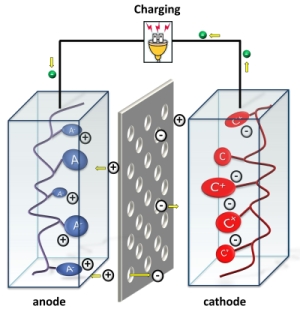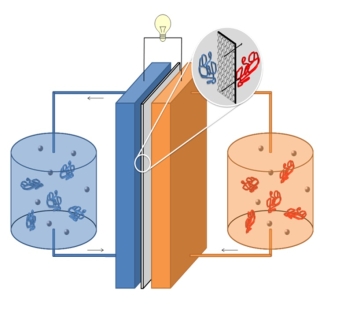Polymer Batteries
Members
Description
|
Energy storage is one of the most crucial elements in the 21st century. Our mobile society requires tailor-made energy storage solutions for several technologies. Additionally, the demand for stationary energy solutions is, due to the unsteadiness of renewable resources, steadily growing. In this context, polymeric (“plastic”) materials offer great possibilities for the fabrication of energy storage devices – from the small scale (e.g., printable batteries) up to the large scale (e.g., polymer-redox flow batteries - pRFBs). The utilization of the organic material circumvents the usage of toxic/harmful and often critical raw materials (e.g., cobalt, vanadium, lead). For printed thin-film batteries cathode active materials can be combined either with metallic (zinc, sodium) or with polymer-based anodes. Due to their polymeric nature, the fabrication can be accomplished by well-known printing techniques (screen printing, roll-to-roll). Also the disposal of organic batteries is easy, because of the absence of heavy metals like cobalt, lead, nickel or similar. Moreover, large scale batteries (i.e. RFBs) for short-term storage of, e.g., wind or solar energy can be fabricated on polymer basis. For this purpose, electroactive polymers can be dissolved in simple aqueous electrolytes of RFBs. By this manner vanadium or other harmful, highly corrosive substances (acids, bromine, chromium) can be replaced allowing a new type of “green” stationary batteries. Low-cost industrial membranes as well as easy-to-manufacture polymeric materials provide an enormous economic potential. |
 |
 |
Publications
- Stability of TMA-TEMPO-based aqueous electrolytes for redox-flow batteries
- Emulsion Polymerizations for a Sustainable Preparation of Efficient TEMPO-based Electrodes
- Micro‐tubular Flow Cell Design Utilizing Commercial Hollow Fiber Dialysis Membranes for Size‐Exclusion Based Flow Batteries
- Synthesis and Characterization of a Phthalimide‐Containing Redox‐Active Polymer for High‐Voltage Polymer‐Based Redox‐Flow Batteries
- An aqueous all-organic redox-flow battery employing a (2,2,6,6-tetramethylpiperidin-1-yl)oxyl-containing polymer as catholyte and dimethyl viologen dichloride as anolyte